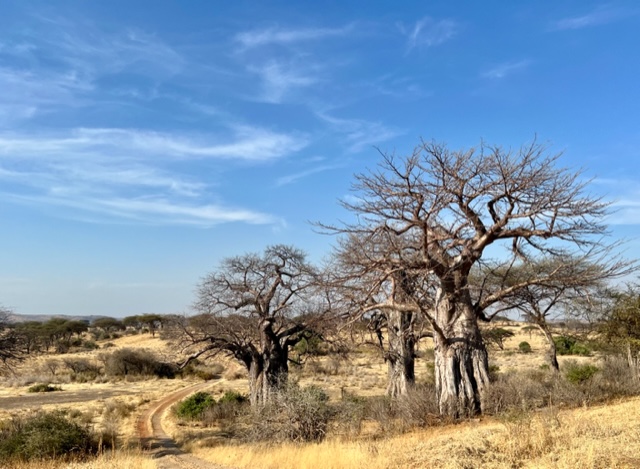
A typical Ruaha vista
I have never been here before, although it is the second-largest National Park in Tanzania. Much more famous and frequently visited are Serengeti, Ngorongoro and Manyara but, having spent so much time in small tented camps like Goliath in Mana Pools, Zimbabwe, I have no desire to go backwards in my safari experiences. So we pick Nomad, which is owned and run by Bimb Theobald, a business partner of our great tea-broking/growing friend Robin H. We made the best choice! This outfit really understands the balance between sustainability and luxury and invests in their staff. A winning combination. On our way in we come across two wild dogs, far from home – the den is miles away. They haven’t been seen for six weeks so we are very lucky.
e second-largest National Park in Tanzania. Much more ver six weeks, so we are very luck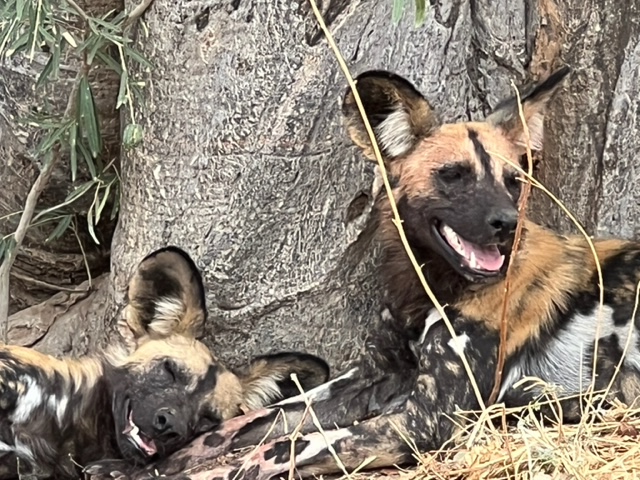
Our tent is huge, with a separate bathroom and bucket shower, primed with hot water for our return each evening. I’m writing this lying on our bed, looking out over the dry river. We have just shouted at four noisy baboons on our roof who ran off, baring their bums in annoyance. Four shy bushbuck frequent us, and we can hear them munching throughout the night. A large leopard flitted by after we were safely delivered to our room one night. This is my dream holiday!
The park is a revelation. Film-set African bush – wide open spaces, with a forest of baobabs, some 2000 years old, yellow bush (it is dry season) peppered with scarlet combretum bushes. Sunrise and sunset are magnificent. Hornbills and doves everywhere, raucous guineafowl on the ground, lilac-breasted rollers on protruding branches. Raptors soaring above – we see Martial eagles, bataleurs, tawny and fish eagles, white-browed coucals, vultures and giant eagle owls, one defending its nest from baboons.
Elephants and impala litter the flood plan, elegant giraffes sashay around the tree line, and the occasional pride of lions can be found supine in the shade. Of course there are the usual suspects – zebra, grant gazelle, dik dik, kudu, large herds of buffalo – one was a thousand strong, jackals, hyena and the rarer oribi antelope. And on the occasional pools, the normal range of water birds – herons, stilts, plovers, saddlebills, hadeda, thick-knees, Egyptian geese, sandpipers and hammerkop.
One morning we take an early morning bush walk. Unlike Mana, we don’t come across any angry or nervous elephant cows and calves. It is more of a nature walk, albeit with a scout and a ranger, both armed; Raphael, our guide, shows us local flora, and ‘the small five’ as he calls them (as opposed to the big five) as the sun rises. We are done in time for our bush breakfast, a highlight of every day, when he unpacks a picnic of fried egg sandwiches, fruit salad and juice, sausages, bacon, mandazis (Swahili donuts) and good Tanzanian coffee. Heaven, eaten on chairs overlooking the bush.
We are in luck as we have hit a purple patch of leopards. The first evening we spot a male by the side of the road in the gloaming; day two morning we chance across a female and her adolescent cubs taking a stroll and we follow them for a bit; day three we arrive a few moments after a young female has killed a huge male impala and is trying to drag it into into the relative safety of a nearby baobab. We follow up on this story throughout our visit as she fends off hyenas and eats as much as she can, disemboweling her prey to lighten the load in the vain chance she can get it up on the tree.
Later that day we also hear about a mother and nine month-old male cub with an impala kill, up two separate trees, due to hyena harassment. He is a youngblood, vain and a poseur, allowing us to snap some incredible shots. It’s a bluff as all he wants is to get back to mum, and he makes a botched attempt to do so, but the hyena is still lurking so it’s back to his tamarind tree. I feel conflicted as we are definitely impeding his return to mum – there are now about five vehicles and we leave him back in the tree waiting for us to go. The next morning there is no sign of them.
On our last night we do a drive after dark, continuing from where we saw 14 lions sleeping earlier in the day. Raphael finds them drinking in the faint light of the new moon; when they finish they climb up the bank led by the alpha female. The three big males are missing so three females lead this boyband. We follow them as they pad away into the bushes, parallel with the road and then, one by one like ghosts they slip away into the bushes. Who could believe these are the same lions we saw earlier? Other highlights include bat-eared foxes, five civets, countless dik diks and a bushbaby.
Our final meandering game drive to the airport takes us back to where the lions might be – and, yes, here they are sleeping again! We watch for a bit but the most they do is chase the shade, so we continue on by the river, enjoying the bird life (more brown snake eagles, fish eagles, giant eagle owl and a tawny) until on the opposite bank Rapha spots two of the pride’s big males under a baobab. We have been wondering where they are. Moving slowly forward, looking for the other missing male, we stumble across two mature females and adolescent male, who is most unhappy to see us. They are staking out a curious giraffe, and a very alert herd of zebras nearby. Rapha is convinced the third of these females is nearby but try as we might we can’t spot her. A grand total of 20 lions on our last day!

Sundowners are wonderful here – the wide open views, the hills in the background and the dust in the dry season make for vermillion skies. Driving back in the dusk is always exciting…
Our five days in Kigelia camp are magical; the food is excellent, service and staff both charming and impeccable, from manager Goodluck, major domo Joseph, down to the askaris who take us to our tent at night. Raphael is so knowledgeable about the plants and animals, and has his eagle eyes: amazingly he spotted a chameleon in a thick bush from the vehicle and can see a tail twitch from a hundred yards.
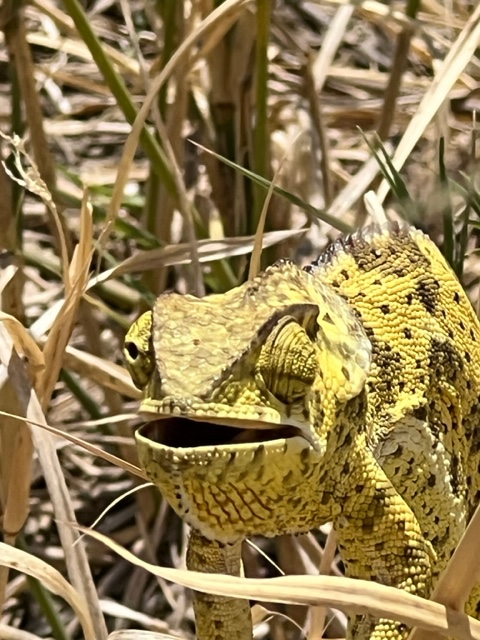
We are also thrilled to bump into Dave Christiansen, a guide we know from Mana days, so reminiscences abound about our dear friend Stretch Ferreira to whom we are sending regular updates about our leopards. So far he has seven wild dog pups and we have seven leopards, so we are even! We will be back to Mana next year – Stretch had better get his leopard sightings lined up! Like us Dave thinks Nomad is the top outfit in Tanzania – he always brings his clients and we would certainly come again.
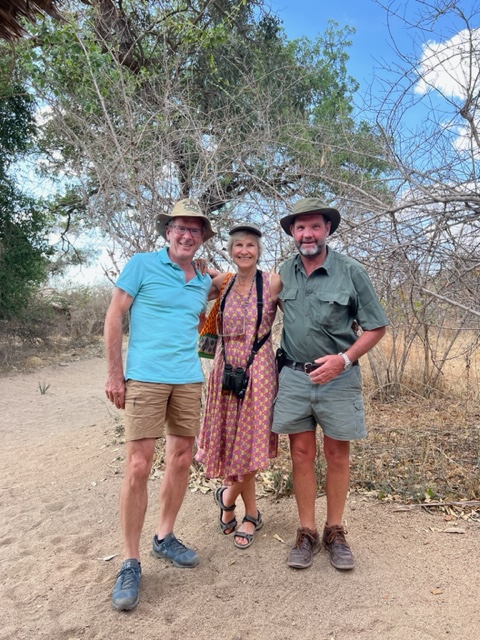
However, this is not a perfect paradise. The Ruaha river used to be fast-flowing all-year round, now it is reduced to a trickle at best, leaving swathes of sandy river bed, where elephants are forced to dig for water. Once teeming with hippo and crocs, we are pleasantly surprised to find a lone pod of hippos running along to the largest surviving pool. Upstream corrupt politicians have diverted the river to irrigate their rice farms. For a while under socialist Magafuli this was stopped, but now it’s worse than ever. How long can this fragile environment survive? Not that long I fear as they’re building a new runway to take bigger planes. Catch it while you can.
And so our fabulous holiday in Tanzania comes to an end. Thank you to Farm Africa for giving us the opportunity to return, even if the holiday is a luxury add-on to the main event – the AGRF conference in Dar. We so hope that the trip will reap the rewards our team deserves – we aim to help farmers grow more, sell more while using sustainable farming methods. We’ve been going almost 40 years so must be doing something right.


PS all photos taken with an iPhone, apart from the three bird pics which are Ross’. Isn’t technology amazing?

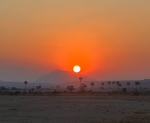





















































September 23, 2023 at 10:05 am
❤️
September 23, 2023 at 12:35 pm
Wh
September 23, 2023 at 5:02 pm
Eh!?
September 28, 2023 at 3:07 pm
TERRIFIC!!!!
September 28, 2023 at 3:27 pm
Come to mana next year! 11-16 September.
September 28, 2023 at 4:26 pm
I’d rather go the place you just described so well. Loved the pics!!
Michael Moller+41766910135Skype: mollerm1michaelmoller@runbox.com
<
div dir=”ltr”>
September 28, 2023 at 4:29 pm
Haha